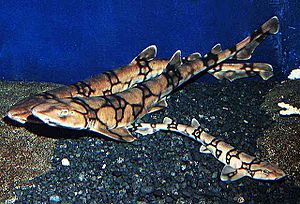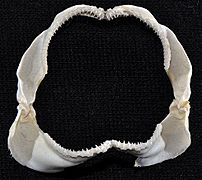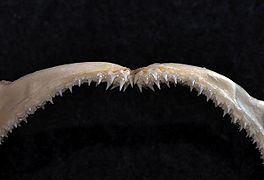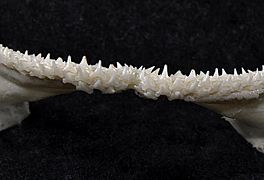Chain catshark facts for kids
Quick facts for kids Chain catshark |
|
|---|---|
 |
|
| Conservation status | |
| Scientific classification | |
| Genus: |
Scyliorhinus
|
| Species: |
retifer
|
 |
|
| Range of the chain catshark | |
| Synonyms | |
|
Scyllium retiferum Garman, 1881 |
|
The chain catshark or chain dogfish (Scyliorhinus retifer) is a small shark. It gets its name from the chain-like pattern on its skin. This shark can also glow in the dark, a process called biofluorescence. You can find it in the Northwest Atlantic Ocean, the Gulf of Mexico, and the Caribbean Sea. It's a harmless shark that people rarely see.
Contents
Where Chain Catsharks Live
The chain catshark lives in the Northwest Atlantic Ocean. Its home stretches from George's Bank in Massachusetts down to Nicaragua and Barbados. In the Mid-Atlantic Bight, these sharks live along the edge of the continental shelf.
They can be found in waters from about 36 meters (118 feet) deep to 750 meters (2,460 feet) deep. In the northern parts of their range, they usually stay between 36 and 230 meters (118 and 755 feet) deep. Further south, they often live deeper than 460 meters (1,510 feet). Because they live so deep, these sharks do not travel long distances.
Water temperature affects where these sharks can live. They prefer water temperatures between 8.5°C (47°F) and 14°C (57°F). Colder water, especially in winter, can limit how far north they can go.
Habitat and Behavior
Chain catsharks spend their daytime resting on the ocean floor. They often hide near structures like rocks or tubes made by anemones. The spotted pattern on their skin helps them blend in with the rocky bottom. This is a great way to stay hidden from other animals.
Adult sharks like rough, uneven seafloors. Younger sharks, however, prefer smoother areas. Chain catsharks eat a variety of foods. Their diet includes squid, small fish, worms called polychaetes, and crustaceans like crabs. In aquariums, they are quiet during the day. But at night, or when it's feeding time, they become very active.
Reproduction and Life Cycle
How Chain Catsharks Mate
When chain catsharks mate, the male often bites the female. He holds on firmly and then wraps his body around her. This allows them to mate. After mating, the male lets go, and they swim apart. They can mate multiple times.
Laying Eggs
Female chain catsharks like to lay their eggs on tall, upright structures. They always lay their eggs in pairs. The time between laying each pair of eggs can be from a few minutes to up to 8 days. The eggs develop faster in warmer water.
Sperm Storage and Egg Cases
Female chain catsharks can store sperm for a long time after mating. They have been known to store sperm for over two years! This means they can lay eggs many days after they first mate. Sometimes, eggs laid much later might not develop as well. This could be due to the female getting older or the sperm not being as strong.
The egg cases are soft and clear when they are first laid. They have two long, curly tendrils. These tendrils are very important because they help the egg cases hook onto rocks or other things on the seafloor. This keeps the eggs safe and in place. Once laid, the egg cases become hard and turn a dark amber color with white bands.
Embryo Development
It takes about 8 to 12 months for a chain catshark embryo to develop inside the egg case. This time can change depending on the water temperature. Here's a typical timeline of how the embryo grows:
- 10 mm (0.4 in) – The embryo starts to show clear gill arches. It also has a thin fin along its belly.
- 21 mm (0.8 in) – Small buds appear where the back fins and pelvic fins will grow.
- 33 mm (1.3 in) – The embryo's eyes begin to stick out. Its gill filaments (parts of the gills) are well-formed.
- 43 mm (1.7 in) – The embryo is no longer clear. Small slits form in the egg case. These slits let water flow in and out, helping the embryo breathe.
- 58 mm (2.3 in) – The fin along its belly starts to disappear.
- 66 mm (2.6 in) – The belly fin and gill filaments are mostly gone or much smaller.
- 74 mm (2.9 in) – The shark looks like a miniature adult. However, it is still absorbing its yolk sac, which provides food.
- 100-110 mm (3.9-4.3 in) – The shark is ready to hatch from its egg case.
Biofluorescence: How They Glow
The chain catshark is one of the few sharks and rays that can glow in the dark. This ability is called biofluorescence. Scientists have studied how these sharks see. They even created a special "shark-eye" camera. This camera showed that the glowing parts of the shark stand out against the dark ocean background.
The fact that many sharks and rays have developed this glowing ability, and can also see it, is very interesting. It suggests that biofluorescence might be important for how these animals behave and communicate underwater. The glowing colors come from special chemicals in their skin.
Chain Catsharks and Humans
People do not usually fish for chain catsharks to eat them.
These sharks are often described as beautiful. Because they are small, they are popular as pets in cold-water aquariums. Many public aquariums display and even breed chain catsharks. Scientists also study these sharks in aquariums and labs to learn more about their behavior and how they reproduce.
See also
 In Spanish: Scyliorhinus retifer para niños
In Spanish: Scyliorhinus retifer para niños





